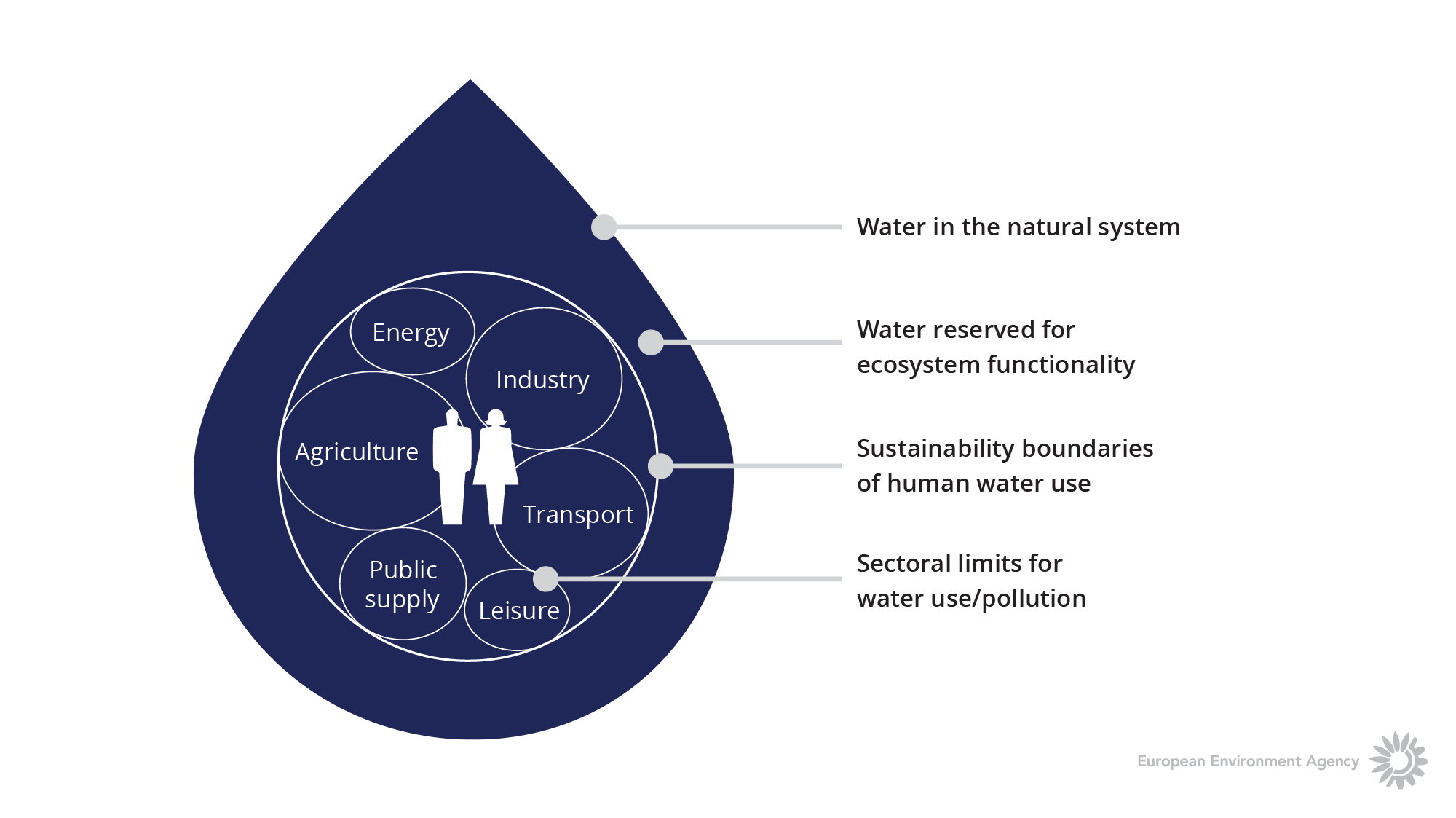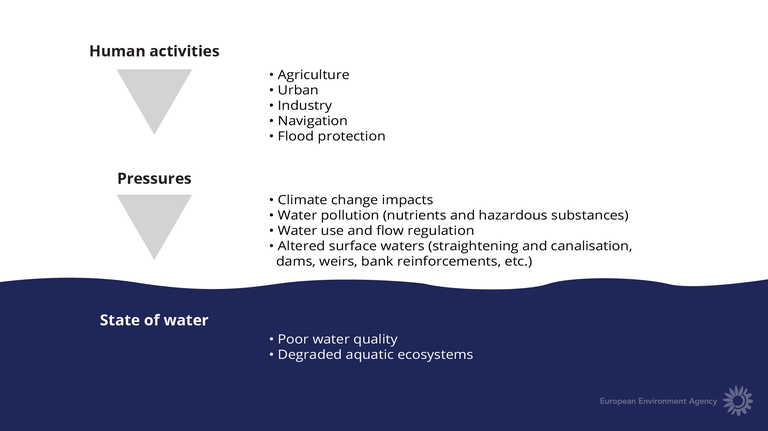Context
Water bodies, their ecosystems and the land and terrestrial ecosystems within their catchments are intrinsically connected with each other and the downstream coastal and marine waters. Together they constitute a hydrological system which is exposed to any changes in water or land further upstream.
For decades humans have polluted and altered European inland waters to enable agriculture and urbanisation, produce energy, and protect against flooding. These activities resulted in poor water quality and altered habitats, with significantly severe impacts on the status of water ecosystems.
Objectives for water from the European Union's (EU) 7th Environment Action Programme (7th EAP),[1] together with those from its Biodiversity Strategy[2] and 'Blueprint to safeguard Europe's water resources',[3] are key components to maintain and improve the essential functions of Europe's water-related ecosystems including coastal and marine areas and to ensure they are well managed.
The natural capital of water ecosystems is highly intertwined and dependant on the way land and water is managed and how pressures from agriculture, energy, transport etc. are reduced within their respective policy areas or how adaptation to climate change is integrated into water management.
To meet the objectives of the Water Framework Directive (WFD)[4] (i.e. all water bodies to have good status by 2015), river basin authorities will have to address the pressures affecting water bodies. Reducing pressures will enable the freshwater ecosystems to recover and place them in a better position to cope with other challenges such as climate change.
Key trends
Pressures from water pollution, over-abstraction and structural change all effect water ecosystems in a systemic way throughout the whole hydrological system. They are caused by activities in several economic sectors.
Agricultural production has become increasingly intensive with high inputs of fertilisers and pesticides. This in turn continuously results in pollutants loads to the water environment. Agricultural activities (irrigation, drainage etc.) are in many places altering freshwater ecosystems. Water storage and abstraction for irrigated agriculture have changed the flow regime of many river basins and lowered groundwater levels, particularly in southern Europe. In northern Europe, many lowland agricultural streams were straightened, deepened and widened to facilitate land drainage and to prevent local flooding.
Policies and demand for increased food production and bioenergy crops, including irrigated agriculture, increase the demand for water. Together with reduced water availability due to climate change, they also further worsen the extent and severity of water scarcity in some parts of Europe.

Previous reforms of the CAP[5] have resulted in a general decoupling of agricultural subsidies from production and the implementation of a cross-compliance mechanism. This mechanism means that farmers must comply with a set of statutory management requirements, including those that relate to the environment. A range of agricultural measures such as the improvement of manure storage, the use of cover crops, riparian buffer strips, and wetland restoration, will play a key role in addressing pressures from agriculture if widely implemented. The new reform of the CAP provides an opportunity to further strengthen water protection.[6]
Urban water management has over many years used rivers only as extensions of the sewage system. Urban rivers have been covered, river banks have been heavily developed, and lakes have been isolated or even filled. Impervious sewage collection systems have changed the water flow regime.
Flood protection and defences relied in the past mostly on 'hard' infrastructure including bank enforcements and dykes, water storage reservoirs, and drainage through straightening rivers and pumping canals.
Some activities related to energy production such as hydropower, use of cooling water and growing energy crops result in pressures on water management.
More than 25 000 hydropower plants in Europe have been identified as one of the main drivers affecting the status of rivers, resulting in the loss of connectivity, altered water flow and sediment transport.
In several EU Member States, an increase in hydropower generation is needed to achieve the 2020 Renewable Energy Directive[7] target of 20% of energy production based on renewables sources. This increase in generation can be achieved by increasing efficiency in hydropower generation at existing sites but also by building new hydropower plants. It is important to ensure that existing and forthcoming EU policies to promote hydropower are compatible with the WFD and clearly consider the impacts on freshwater ecosystems.
Around 40 000 km inland waterways play an important role in the transport of goods in central Europe. These waterways are generally seen as more environmentally friendly than road transport. However, navigation activities and/or navigation infrastructure works are typically associated with changes in the morphology (channel maintenance, dredging, channelisation and straightening, bank reinforcement) and hydrology, spread of invasive alien species and pollution (oil spills and anti-fouling paints and other substances used to prevent the attachment of unwanted organisms to ships).
Thus, despite the advantage of these sectors and policies for society, there is a need to strike a balance between the benefits and the impacts on freshwater ecosystems.
Prospects
Until the last 20 to 30 years, the main focus of physical water management in many parts of Europe was on providing flood protection, facilitating navigation, and ensuring the drainage of agricultural land and urban areas. Nowadays, water management increasingly includes ecological concerns, working with natural processes.
This is in line with the objective of the 7th EAP 'to protect, conserve and enhance the Union's natural capital'. It is also consistent with Target 2 of the EU's Biodiversity Strategy that aims to ensure maintenance of ecosystems and their services by establishing green infrastructure and restoring at least 15% of degraded ecosystems by 2020. This target means that degraded freshwater ecosystems must also be restored.

Restoring freshwater ecosystems such as 'making room for the river', river restoration or floodplain rehabilitation has multiple benefits for the water ecosystems. The EU-wide Green Infrastructure strategy[8] includes rivers and floodplains as important elements.
The strategy aims to reconnect existing nature areas and improve the overall quality of ecosystems. It also includes natural water retention measures (NWRMs)[9] that aim to increase soil and landscape water retention and groundwater recharge. These measures help deliver equally the WFD objectives and the EU Biodiversity Strategy's restoration target.
Managing water in a green economy means using water in a sustainable way in all sectors and ensuring that ecosystems have the quantity and quality of water needed to function. It also means fostering a more integrated and ecosystem based approach involving all relevant economic sectors and society. This integration throughout the river basin is enhanced by, for example, public participation and stakeholder involvement.
Urban rivers have become increasingly important in the planning of urban ecology, green infrastructure and green areas in European cities in recent years. River and lake restoration, in connection with other projects like rainwater harvesting and wetland spaces for city development and urban planning, are offering situations with mutual benefits; improving flood control and ecological functions, while offering recreational value and raising the quality of life in urban areas.
To avoid negative impacts from future navigation activities, close cooperation between the navigation sector and water and nature managers is required. The European Commission has issued guidelines on inland navigation and nature protection to assist the sector in applying EU environmental legislation.[10]
The main challenge in managing water resources efficiently is to meet the reasonable needs of the different water users, while leaving enough water with the appropriate hydrological regime in the environment to conserve freshwater ecosystems (Eflows). Where water resources are overexploited or the hydrological regime is altered e.g. by dam operations, Eflow requirements impose a change of the hydrological regime and/or a reduction (a cap) for water abstractions by sectors. Together with the European Commission, the EEA is developing water accounts at the river basin level to inform the aspect of over abstraction and the need for the increase in water use efficiency.
In the coming years, climate change will increase water temperature and the likelihood of flooding, droughts and water scarcity. There are many indications that water bodies already under stress from pressures are highly susceptible to climate change impacts, and that climate change may hinder attempts to restore some water bodies to good status. Here the establishment of good ecological and healthy ecosystem conditions are extremely important. Good ecological status will also increase the resilience of the ecosystem, i.e. its capability to absorb additional adverse pressures.

Document Actions
Share with others